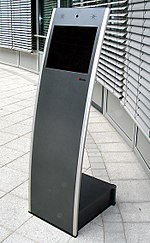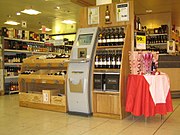Kiosk system

Kiosk systems are interactive computer systems that are used in public spaces or in semi-public locations, such as in shop areas. In contrast to mobile computer devices, they are assigned a fixed location. They provide information to users. Some also offer the opportunity to initiate or conclude business. Kiosk systems are self-service terminals . Their use can save staff.
Computer systems that are also used in public and offer access to the thematically unlimited world of the Internet must be distinguished from kiosk systems . These are called Internet terminals or surfing or multimedia stations .
Areas of application
Kiosk systems usually only offer access to those application programs with which the operator / owner wants to disseminate information. They provide information about magazines, newspapers, companies, timetables or historical buildings. You can find them in the normal public or in a closed but anonymous public, e.g. B. at trade fairs .
The first kiosk systems were called POI systems (POI: Point of Interest or Point of Information) or POS systems (POS: Point of Sale or Point of Service). They made information available to the user at airports or train stations , sold tickets or tickets and offered the user a high degree of self-service.
If the term kiosk system is taken broadly, ATMs can also be counted among the kiosk systems.
User groups
The use of the systems can be anonymous, i. H. without personal identification. However, some systems provide for the entry of an identifier (user ID, password, personnel number, customer number, etc.) and are then able to offer personalized information.
There are countless applications for closed user groups (CUG) on the market, for example for personnel time recording as a time clock .
There is data output via kiosk systems in company areas that usually do not have computer workstations, especially in factory buildings and in the open air. They are also found in areas that can only be entered by persons with special authorization, i.e. in areas in which identification is carried out using club cards, membership cards, customer cards or the like.
Limitation of the range of use
The usage concepts of kiosk systems provide for limited user interfaces. There is only access to the absolutely necessary programs. If web browsers are used, they are configured in such a way that there is a limited range of use. With these measures, increased operational safety and stability can be achieved in continuous operation.
In a simple kiosk system, the hypertext system offers only a small number of branch options and a limited number of pages that can be called up. It is a system with a reduced hierarchical depth and complexity.
Operating concepts
The operating concept of a kiosk system can provide for use while standing or sitting. What is appropriate in each case results from the intended target group and the optimal length of stay. Accessibility is provided for information systems in the community . They must therefore be usable for people in wheelchairs in the same way as for people without restrictions.
Kiosk systems are often available to users around the clock. Under such circumstances, it is not possible to predict precisely which user groups will join and what level of knowledge they will bring with them in the use of computer tools. Kiosk terminals should therefore have an easily accessible, intuitive and easy to use user interface.
While users want an easy-to-understand operating concept, on the other hand there may be device, location and content providers who expect a poor operating concept to spend a longer time on the device and thus greater advertising benefit.
Reasons for Use
One of the greatest advantages of kiosk systems over other information offers is that the service provider does not have to have on-site staff and that the systems can also be used outside of normal working hours. In addition, products that are to be presented do not have to be physically present.
New concepts for conveying information can be implemented with kiosk systems. One example is systems in the sales areas of retail stores. They offer the customer the opportunity to independently find out about the products offered for sale. The process can look like this: the customer carries the product he is interested in to the kiosk system; there the EAN number is read in via a scanner. All information can then be displayed for which there was not enough space on the adhesive label. For example, if the customer carries a bottle of wine to the kiosk system, the system can indicate the optimal maturity and shelf life, the ideal drinking temperature, and the question of which dishes the wine goes with can also be answered.
Information can be offered at locations where the provider usually does not have a local presence, so-called third-party locations. For example, a concert organizer can set up a device in a ticket sales point with which concert dates can be queried. With such a cooperation, the point of sale benefits because the customers have additional reasons to visit their premises, and the concert promoter benefits because the information they offer reaches an interested audience.
In the meantime, however, kiosk systems are no longer used only for information purposes, but also to provide a constantly present and open feedback channel in the complaint management process . The feedback can then be evaluated digitally thanks to the kiosk system. Kiosk systems with such a feedback function are used primarily in the catering and hotel industries.
There are kiosk systems that can be financed through advertising. The better these systems succeed in creating recognition effects that are effective for advertising , the more money is available to increase the efficiency for customers with complex and expensive functions.
social acceptance
Due to cultural differences, the social acceptance of kiosk systems looks different in different countries. The spread and acceptance is much more advanced in the Anglo-Saxon countries than in the German-speaking countries. In public libraries, kiosk systems are not only available for automatic search and for borrowing and returning, but are also part of the established picture with free or paid unlimited internet access. In the German-speaking countries, however, the spread of kiosk systems is still in the early stages.
See also
literature
- Günther Silberer, Lars Fischer (Eds.): Multimedia kiosk terminals: information filling station, telecommunication points and smart shops of the future . Gabler, Wiesbaden 2000, ISBN 3-409-11667-2 .
- Lars Fischer: Kiosk systems in retail: Use, acceptance and effects . Deutscher Universitäts-Verlag, Wiesbaden 2002, ISBN 3-8244-7648-7 .
- Wieland Holfelder: Multimedia kiosk systems: information systems you can touch . Friedr. Viehweg & Sohn, Braunschweig / Wiesbaden 1995, ISBN 3-528-05468-9 .
- B. Stauss, W. Seidel: Complaint Management: Dissatisfied Customers as a Profitable Target Group. 4th edition. Hanser, Munich / Vienna 2007, ISBN 978-3-446-40593-6
Web links
Individual evidence
- ↑ B. Stauss, W. Seidel: Complaints Management: Dissatisfied customers as a profitable target group. 4th edition. Hanser, Munich / Vienna 2007, ISBN 978-3-446-40593-6 , pp. 106ff.

